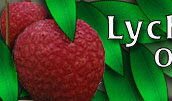8 Essential Factors for Growing Healthy Lychee Trees
By William Mee & Krystal Folino
- No Wind:
Perhaps the single greatest enemy of developing lychee trees is wind. When
a lychee puts out new growth these new leaves are very tender and delicate.
Even a moderate amount of wind (> 15mph) will damage these new branches and
leaves. Lychee trees that are well protected from the wind will grow
extraordinarily well.
When a tree flushes with new growth it is utilizing stored energy, in the
form of sugars, starches and electrolytes, from the tree. If this new
growth is destroyed or damaged when the tree is relatively small there
is little reserve left to regenerate further replacement growth. A small
tree planted in a wind-exposed field may experience severe growth
retardation by a factor of several years.
We have successfully used bananas as wind breaks between the trees
because, in our area, they grow so fast and are so hardy. Besides acting
as attractive wind breaks, bananas produce a lot of organic material that
falls on the ground adjacent to the lychees.
- Soil Conditions:
Lychees prefer an acidic soil as do most tropical fruit trees. Soil pH
plays an important role in the nutritional health of a tree particularly
with respect to the trees ability to absorb minor elements such as iron.
Organic material in the soil generates humic acids as it breaks down.
These naturally occurring acids help to lower the soil pH and promote a
healthier growing environment.
While lychees can tolerate standing water for up to two weeks this
situation is definitely not a good one. Trees exposed to excessive
water, such as those planted in a low poorly drained area will display
significant stunting of their growth. Standing water prevents the roots
from breathing and this will eventually lead to root death and subsequently
death of the entire tree.
In our grove we have a certain area that gets a lot more standing water
than other sections. The trees in this area are one half the size of other
trees planted in drier sections.
Do not ever bury the root crown of a lychee. This general rule applies to
most all trees. The root crown is the zone of plant tissue at the base of
the tree between where the roots leave off and the trunk begins. If this
area is buried by non porous soil it will lead to death of the tree just
as if you took a knife and cut a slit (girdled) the base of the tree.
If you are growing a lychee tree in limestone (high pH) soil such as that
found in the South Miami area it may be necessary to apply a foliar spray
of minor elements. Chelated iron is the most important of the minors.
- Root Zone:
Keep the root zone free of grass, weeds and any other debris that may
either steal nutrients of block them from reaching the tree's root system.
As stated before, lychees have a spreading surface root system. If you
allow grass to grow directly over and on top of the roots fertilizer and
other nutrients applied to the tree will never make it to the roots.
It is typical of dooryard plantings to allow grass to grow directly
adjacent to the tree trunk. This introduces another major hazard - weed
whackers. Lawn maintenance people will attempt to use their string weed
whackers close to the tree trunk and in the process "girdle" the tree.
Watch out for vines and tall weeds that might get started in the root zone.
There are a variety of vines whose seeds land below the leaf canopy that
when germinated can quickly envelop the entire tree in a matter of months.
These vines act to block the available sun light from reaching the tree and
will retard growth as well as making a mess.
When removing vines from a lychee you should always remove the entire vine
from the tree and not simply cut the vine stem. Some arboreal vines have so
much stored energy that they will send down runners that will reconnect
with the ground and jump start the vine.
Vines, since the are usually green are hard to spot until they have almost
taken over an entire tree. Be vigilant.
There is a particular obnoxious vine, similar to kudzu, that we called a
stealth vine. This sneaky vine blends in with the color of the tree and
you can look directly at one of these vines in a tree an not see it. Before
too long the vine has completely covered the entire canopy and it is a
major nuisance to remove it.
- Full Sun:
If you allow a lychee to become shaded it will stop growing. If a lychee is
shaded by an adjacent tree, it will not set fruit on the shaded section.
The situation became so dire in our grove that we had to remove every other
tree.
When we first planted our grove we attempted to maximize the
utilization of space in our grove and maximize fruit production by
planting all the trees the grove would hold. As it turned out this was not
such a good idea. As the trees developed, they grew into each other thereby "shading out" most of the grove. Moving the trees to another grove was no small undertaking as many of the trees were as high as 20 feet. More trees do not necessarily mean more fruit.
If you have the land, the optimal spacing for a lychee tree is a 15' radius
from the center of the trunk in all directions. If you leave 10 or more
feet access between rows this implies a row spacing of 40'. This may seem
like a lot, but some of the trees on the adjacent property that were planted
on 30' center 30 years ago are now overshadowing each other and require
major pruning.
Basically, the area around the tree should be free of other plants, trees
and have full sun exposure on all sides at some time during the east west
progression of the sun.
- Mulch:
Organic mulch such as that derived from yard waste and chipped material
helps to promote a uniform healthy micro-climate above the roots. This
reduces the stressful cycle of wetting and drying of the root system. These
conditions also make for a healthy environment for soil building
micro-organisms such as bacteria and fungi.
Most lychees are propagated as
air-layers (vegetative) and as such develop a shallow root system that
spreads across the surface without a deep taproot. The decaying organic
matter in mulch assists in acidifying the soil, which is especially
important in the limestone soils of the tropics and in particular South
Miami.
Lychee trees develop a hemispherical shape that creates a canopy
to naturally shade the root system. Mulching effectively enhances the root
shading properties of lychees.
- Pruning:
We have found that trees that have been pruned back about 6" after
harvesting the fruit tend to produce more fruit in subsequent years.
Pruning of the older growth stimulates new growth on all of the
meristematic terminal ends. The leads to a fuller, bushier tree that will
have a greater surface area and will probably produce more fruit. Remember
that the bloom spikes form on recent growth that has "hardened off" within
the last several months.
One objective of pruning should be to encourage the tree to achieve the
optimal hemispherical habit of growth. This shape will provide the best
shade to the root system and encourage a healthier tree overall. Another
benefit of shading the root system out to the drip line of the tree is that
the shade deters the undergrowth of weeds, grass and undesirable volunteers
that rob essential nutrients.
- Fertilizing:
Lychees exhibit a slow to moderate growth rate. This can be tremendously
accelerated through proper and effective fertilization. If your objective
is to get size on a tree rather than fruit it is possible to push a tree
very significantly during a single growing season. The rule of thumb for
fast growth is "once a month" applications of a balanced fertilizer during
spring and summer.
We have doubled the size of some of our trees in a
single growing season through aggressive fertilization. If you are a
homeowner and are in a position to lavish TLC on your tree we would
recommend using a time-release fertilizer such as Sierra Osmacote.
Time-release fertilizers release nutrients only when the fertilizer pellets
are exposed to water. Regular bulk fertilizers may completely dissolve into
the soil after a heavy rain leading to burning of the root system and death
of the tree.
We have observed numerous examples of people applying a heavy fertilizer to
a tree only to watch it die after a heavy rain. If it hadn't rained in a
while sometimes it was hard to relate the cause of death to the act of
fertilizing. The giveaway to a fertilizer death is a sudden browning of the
leaves after a particularly heavy rainfall. Remember, "a little is good
but a lot is not always better".
- Pests:
Lychee pests are very specific to the locale of the tree. In our grove in
South Florida we get weevils, webworms and fungus. While there are lots of
noxious life forms to be found on the trees such as ants, scale, lichens
and stink bugs the big troublemakers are aforementioned nasties.
Weevils and various types of beetles seem to cause the most damage to new
leave growth, especially before the new growth has hardened off. These
pests generally will not kill a tree although the weevils can severely
retard the growth of a young tree by eating or damaging much of the new
growth, thereby slowing development. The larval form of the weevils will
eat the exterior covering of the roots and if they are in sufficient
quantity can kill the tree.
Lychee trees are more susceptible to pathogens and fungus when they are
stressed. Trees in our grove that have been subjected to an excessive
amount of water tend to have much smaller canopies and a higher level of
lichen infestation.
Weevils on the foliage are easily controlled with pesticides such as
sevin. We do not use pesticides in our grove as the marginal improvement
in productivity is not worth the long-term risks associated with pesticide
exposure.
The larval weevils can be controlled by the application of a beneficial
parasitic nematode; however this is very expensive and time consuming and
is only a last resort effort when major damage is threatening.
Many growers spray a range of conventional pesticides, particularly to
control the webworm, which damages the small fruit after they have set.
The pesticide used to control these worms costs nearly $500 per gallon
and requires several applications.
In keeping with our organic perspective we would rather lose some fruit rather than run the risk of the long-term effects of low-level pesticide exposure.
by Bill Mee & Krystal Folino - Lychees Online
Are you a lychee enthusiast? Get your FREE Lychee Idea-Kit or browse hundreds of lychee recipes, photos, tips and articles on eating and growing lychees at the Lychees Online Website
http://www.lycheesonline.com
Webmasters, editors, publishers, press, growers, marketers, etc. are free to reprint this article as long as it's reprinted in its entirety and the signature line remains intact.
Please direct a courtesy copy to info@lycheesonline.com or snail mail it to:
Lychees Online
4778 Stono Links Drive
Hollywood, SC 29449
Back To Lychee Info
|
|
|
Copyright © 1999-2010 Lychees Online
info@lycheesonline.com www.lycheesonline.com (954)648-6020
|

